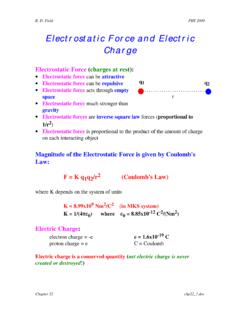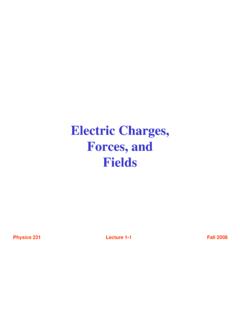Transcription of Worked Examples - Massachusetts Institute of Technology
1 Massachusetts Institute OF Technology Department of Physics Fall, 2002 IV. Gauss s Law - Worked Examples Example 1: electric flux due to a positive point charge Example 2: electric flux through a square surface Example 3: electric flux through a cube Example 4: Non-conducting solid sphere Example 5: Spherical shell Example 6: Gauss s Law for gravity Example 7: Infinitely long rod of uniform charge density Example 8: Infinite plane of charge Example 9: electric field of two infinite parallel planes Example 10: electric Potential of a uniformly charged sphere of radius a 1 Example 1: electric flux due to a positive point charge Consider a positive point charge Q located at a point P.
2 The electric field of this charge is given by 0> 201 4Qr =ErG ( ) where r is a unit vector located at the point , that points fromQto the point . What is the flux of the electric field on a sphere of radius centered on? PPrQ Solution: There are two important things to notice about this electric field . The first point is that the electric field is constant in magnitude on a sphere of radius centered on the chargeQ. The second point is that the electric field points radially away from. rQ Let s calculate the flux of the electric field on a sphere of radius centered on.
3 First we choose a small patch of that sphere of radius rQ Ai. Figure Flux of a point charge on a sphere Since the electric field at each point on the sphere points outward from the center of the sphere, it is perpendicular to the plane of the patch. So the electric flux through this patch is (Eiii201 QEAA4r = = ) ( ) The total flux through all the patches is just the sum, 2 iNEiNi1 SlimEAE dA= = = w ( ) The crucial point to notice is that the electric field is constant on the sphere.
4 This means that the electric field can be pulled in front of the summation sign, (or equivalently outside the integration) ESEdA = w ( ) The summation of the small area elements over all the patches is just the total area of the sphere 2 SdAA4r == w ( ) So the flux is just the product of the magnitude of the electric field with the area of the sphere, (similar to the calculation for a constant field on a square area), 2E2001 QQEA4r4r === ( ) where 12220922188410 CNm4(9010 NmC).
5 == ( ) is the permitivitty of free space. This calculation for a point charge will be the basis for Gauss s Law. Notice that the crucial property of the electric field is it s inverse square dependence on distance . If the field were any other power of , the flux would no longer equal rr0Q for a point charge and Gauss s Law would not be true! 3 Example 2: electric flux through a square surface Compute the electric flux through a square surface of edges 2l due to a charge +Q located at a perpendicular distance l from the center of the square, as shown in Figure Figure electric flux through a square surface Solution: The electric field due to the charge +Q is 220011=44 QQxy rrr ++= iz jkErG ( ) where r=(x2+y2+z2)1/2 in Cartesian coordinates.
6 On the surface S, y=l and the area element is dd( Adxdz==A)jjG. Since 0 =ij=jkand 1 jj=, we then have 200()44 QxyzQl ddxdzdxdzrrr ++ = ijkEAj=GG3 ( ) Thus, the electric flux through S is 12212222322222212000011002222124()4tan22 (2)tan(13)tan(-13)26()()()(2)/llE/ll/Sll lllll/lQldzQlddxxlzxQlQxlQQ//zxlxlzdxldx xlxl = =++==+ = = +++++ EA=GGw 4 ( ) 06EQ = where the following integrals have been used.
7 223/22221/2221222221/2221/2222()()1tan,( )()()()dxxxaaxadxbabaxaxbabaaxb =++ 2=>++ + ( ) Example 3: electric flux through a cube Place a charge +Q at the center of a cube of side 2l (Figure ), what is the total flux emerging from all the six faces of the closed surface? Figure electric flux through the surface of a cube Solution: From symmetry argument, the flux through each face must be the same. Thus, the total flux through the cube is just six times that through one face: 0066 EQQ == ( ) The result shows that the electric flux E passing through a closed surface is proportional to the charge enclosed.
8 In addition, E is independent of the shape of the closed surface. 5 Example 4: Non-conducting solid sphere An electric charge is uniformly distributed throughout a non-conducting solid sphere of radius . Determine the electric field everywhere inside and outside the sphere. Q+a Solution: Step 1: The charge distribution is spherically symmetric. Step 2: Since is uniformly distributed throughout the volume, the electric field EQ+G must be radially symmetric and directed outward. The magnitude of the electric field is constant on spherical surfaces of radius . r Step 3: The charge density of the sphere is uniform and given by ()3 QQV43a == ( ) where V is the volume of the sphere.
9 The charge distribution divides space into two regions, 1. ra 2.. ra Region 1: Consider the first case where ra . Step 4a: We choose our Gaussian surface to be a sphere of radius , as shown in Figure below. ra Figure Gaussian surfaces for uniformly charged solid sphere with ra Step 5a: The flux through the Gaussian surface is ()2 ESdEAE4r = == EAGGw ( ) 6 Step 6a: The charge distribution is uniform. Therefore, the charge enclosed in the Gaussian sphere of radiusis r 3inV4qdVVr3 == ( ) Step 7a.
10 We can now apply Gauss s Law and equate inE0q = ( ) This becomes ()204E4rr3 = 3 ( ) We can now solve for the magnitude of the electric field in the region , ra 300rQrE,34ara == ( ) Region 2: We now repeat steps 4 through 7 for the second region, . ra Step 4b: We choose our Gaussian surface to be a sphere of radius, as shown in Figure below.

















